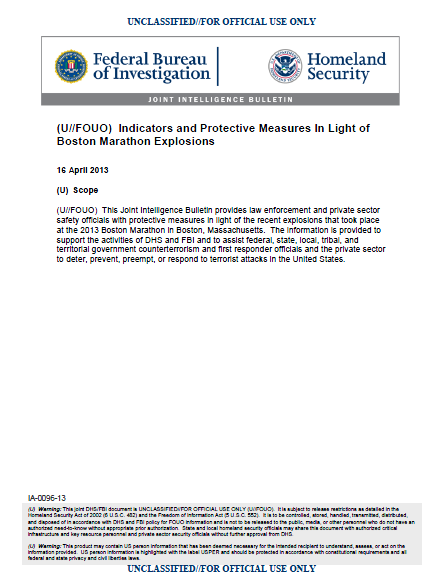The following bulletin was obtained from the website of the Georgia Hospital Association.
DHS-FBI Joint Intelligence Bulletin
- 4 pages
- For Official Use Only
- April 16, 2013
(U//FOUO) This Joint Intelligence Bulletin provides law enforcement and private sector safety officials with protective measures in light of the recent explosions that took place at the 2013 Boston Marathon in Boston, Massachusetts. The information is provided to support the activities of DHS and FBI and to assist federal, state, local, tribal, and territorial government counterterrorism and first responder officials and the private sector to deter, prevent, preempt, or respond to terrorist attacks in the United States.
(U) Incident Details
(U) On 15 April 2013, at approximately 2:45 pm, two explosions occurred in quick succession near the finish line of the Boston Marathon, killing at least three people and causing numerous injuries.
(U) Ongoing Concerns with Terrorism in the Homeland
(U//FOUO) The activities in Boston highlight the use of improvised explosive devices (IEDs) to target large gatherings, including at special events, in order to inflict mass casualties. Examples of previously attempted or plotted IED attacks include:
— (U//FOUO) The undetonated IED discovered along the planned 2011 “Martin Luther King Jr. Unity March” parade route in Spokane, Washington;
— (U//FOUO) The November 2010 plot to detonate a vehicle-borne IED (VBIED) at an annual Christmas tree lighting ceremony in Portland, Oregon;
— (U//FOUO) The October 2010 plot to conduct multiple mass casualty bombings at Metrorail stations in Washington, DC;
— (U//FOUO) The May 2010 attempted detonation of a vehicle-borne IED in Times Square; and
— (U//FOUO) The September 2009 plot to attack the New York City subway using IEDs.(U//FOUO) Indicators of Pre-Operational Surveillance and Attack Planning
(U//FOUO) Given these events, we are providing indicators and protective measures to aid law enforcement and first responders in identifying and mitigating potential threats. Each indicator listed below may be by itself, lawful conduct or behavior and may also constitute the exercise of rights guaranteed by the US Constitution. In addition, there may be a wholly innocent explanation for conduct or behavior that appears suspicious in nature. For this reason, no single indicator should be the sole basis for law enforcement action. The totality of behavioral indicators and other relevant circumstances should be evaluated when considering any law enforcement response or action.
(U//FOUO) Possible indicators of pre-operational surveillance or attack planning include:
— (U//FOUO) Unusual or prolonged interest in or attempts to gain sensitive information about security measures of personnel, entry points, peak days and hours of operation, and access controls such as alarms or locks;
— (U//FOUO) Observation of security reaction drills or procedures; multiple false alarms or fictitious emergency calls to same locations or similar venues;
— (U//FOUO) Discreet use of cameras or video recorders, sketching, or note-taking consistent with pre-operational surveillance;
— (U//FOUO) Interest in speaking with building maintenance personnel;
— (U//FOUO) Observation of or questions about facility security measures, to include barriers, restricted areas, cameras, and intrusion detection systems;
— (U//FOUO) Observations of or questions about facility air conditioning, heating, and ventilation systems;
— (U//FOUO) Suspicious purchases of items that could be used to construct an explosive device, including hydrogen peroxide, acetone, gasoline, propane, or fertilizer;
— (U//FOUO) Suspicious activities in storage facilities or other areas that could be used to construct an explosive device; and
— (U//FOUO) Attempted or unauthorized access to rooftops or other potentially sensitive areas.

